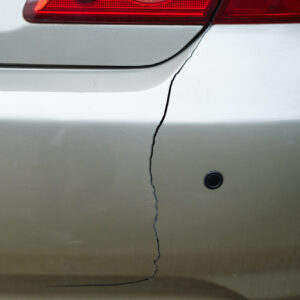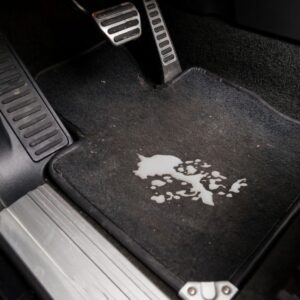A carpet kit is an effective and easy way to install and maintain your vehicle’s carpet. So whether you’re upgrading your car’s interior or tackling stubborn stains, having the right tools and knowing the proper steps make the job a whole lot easier.
Even with mats on top of them, a vehicle’s carpet is susceptible to damage, as it’s constantly stepped on. Lucky for you, there are different ways to fix a hole in a vehicle carpet.
How to Use a Carpet Kit

Before using a carpet kit, ensure you have the following items on hand:
- Vacuum
- Automotive-grade adhesive
- Handheld steamer
Afterward, follow the steps below:
- Step 1: Prepare the area by removing interior components. These include the seats, center console, or anything that might obstruct the installation.
- Step 2: Vacuum and clean the floor.
- Step 3: Position the carpet by laying it in the car. Ensure it properly fits and trim any excess material if necessary.
- Step 4: Use a handheld steamer to relax the carpet fibers to allow them to conform to the floor’s contours.
- Step 5: Apply automotive-grade adhesive to secure the carpet in place. Make cuts for seat belt holes, dimmer switches, and other necessary openings.
- Step 6: Use adhesive or clips to secure the carpet along the edges.
- Step 7: Reinstall the interior components you removed.
Specific instructions could vary depending on the type of car and carpet kit you’re using. Follow the manufacturer’s guidelines or consult with professionals for more detailed instructions.
How to Clean Vehicle Carpets
One way to avoid repairing or replacing carpets is to keep them clean. To do so, you’ll need the following items:
- Vacuum
- Stain removers/All-purpose cleaners
- Borax
- Carpet cleaner
- Carpet brush
- Steam cleaner
Afterward, follow the steps below:
Remove Clutter
Before cleaning the carpet, it’s ideal to remove the clutter inside your vehicle. This will make it easier to remove the carpet. Once you’re done, remove the floor mats if you have any.
A heavily soiled carpet could mean dirty car seats, as dirt and garbage would have accumulated around them. Remove the seats by unbolting the bolts holding the railings and unplugging the electrical connector.
Vacuum the Carpet
Vacuum the carpet and use a brush attachment or a separate carpet brush to scrub the fibers. This lets you break up dried mud into pieces and remove dust as well as small debris between the fibers.
You can also use an air compressor to blow the debris out of the carpet. Don’t rush this step, as it makes it easier to thoroughly clean the carpet later on.
Deal with the Stains
The final step before washing the carpet is dealing with the stains. Different stains require different solutions. To make cleaning easier, refer to the table below:
| Stain Type | Causes | How to Remove |
| General Stains | Dirt and mud | Use a mixture of water with one cup of white vinegar and a few drops of dish soap |
| Beverage Stains | Coffee, alcohol, soda, tea, etc. | Use a paper towel to extract the liquid if it’s fresh. Afterward, pour cold or carbonated water to dilute the stain and prevent it from drying |
| Grease Stains | Food and grease | Use a degreaser to remove the stain. Most, if not all, dish soaps have degreasers on them |
| Ink Stains | Pens and markers | Use rubbing alcohol and a cotton ball to blot the stain. Repeat until the stain is gone |
| Animal and Cigarette Smell | Pets and cigarettes | Put borax on your carpet and leave it overnight. Then, vacuum the carpet the following day to see if the odor has subsided. |
Wash the Carpet
Brush the carpet using a cleaning solution to deep clean and deodorize it. Use a nylon brush to get as much dirt out of the carpet as you can. Add more cleaning solution if needed, but try to keep the carpet dry.
Use microfiber towels and drag them over the carpet to remove the solution and moisture.
Dry the Carpet
Drying the carpet ensures it doesn’t mold. You can use a wet/dry vacuum machine or a hot water extractor to remove most of the moisture, leaving it damp. If you don’t have this device, an alternative would be to lay and press dry rags on the carpet to absorb the liquid. Afterward, use fans to air-dry the carpet.
Some owners make the mistake of rolling the windows all the way for a week. Avoid doing so, as mold or mildew may develop.
Get Perfect Fit Carpets for Your Vehicle Online
Your vehicle’s carpet provide a soft floor surface and help dampen road noise, so take good care of it. And, if it’s damaged beyond repair, don’t put off replacing it. Luckily, shopping for carpet sets for your vehicle is easy and convenient here at CarParts.com.
When searching for carpet kits, you need to find a set that meets your vehicle’s exact measurements and specifications. Good thing CarParts.com is a one-stop shop for all sorts of interior vehicle accessories.
We source our carpet kits from the most reputable manufacturers in the industry. Our sets are made with precise specifications, ensuring a perfect fit and no excess edges. Use our vehicle selector to narrow down our catalog to the sets designed for your ride.
Shop for a carpet kit for your vehicle here at CarParts.com today!
Any information provided on this Website is for informational purposes only and is not intended to replace consultation with a professional mechanic. The accuracy and timeliness of the information may change from the time of publication.




















